My story - Nuovo Progetto
Menu principale:
My story
My story as a harpist  My first touch with the professional musical environment took place in 1970, when I was eighteen and I was still attending my course at the Conservatory of S.Cecilia in Rome.During that period M°Renato Fasano was the director of the Conservatory; meanwhile he was also managing as director and conductor of the ensemble “I Virtuosi di Roma”, a small, outstanding,Italian string group, famous all over the world as a performer of Vivaldi’s Concertos as well as of the Italian operas of the XVIIth century.From 1970 to 1976,at first as a student of the Rome Conservatory and later on as a professional harpist, I had the opportunity to be part of this group and to perform together with them “Egisto” and “Ormindo” by Francesco Cavalli in Venice(Scuola di S.Rocco),Washington(Kennedy Center) Lugano(Radio) etc.The role I had to play was to perform the “continuo” together with M°Enzo Altobelli(cello) and M°Riccardo Castagnone(harpsichord). Scuola di San Rocco 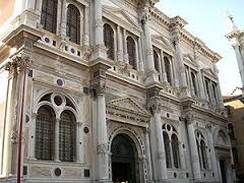 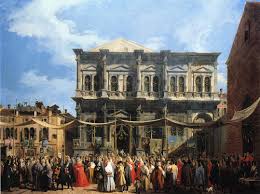 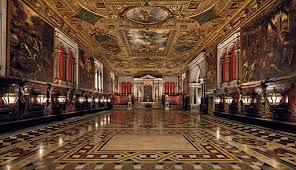 | ||
Pretty much in the same years(1971-1977) I took part in the chamber contemporary orchestra named “Nuova Consonanza”, musical director Marcello Panni and managing director Francesco Carraro.After a short period its name was changed in “Solisti di Teatromusica”,a small group of instrumentalists especially devoted to the contemporary Italian music. We performed works of a lot of composers, above all Petrassi, Dallapiccola, Berio, Bussotti, Donatoni, Pennisi, Sciarrino etc. for several musical associations, such as Accademia Filarmonica Romana, Amici della Musica di Perugia, Teatro Comunale di Bologna, Biennale di Venezia, Unione Musicale Torino, Madrid, Berlin, Saarbrucken, EstateFiesolana, GenoaTeatro Comunale, Accademia Chigiana Siena, Festival de Royanne, Aix-en Provence, Paris Festival d’Automne, Académie de France à Rome, Teatro Argentina Roma, Piccola Scala Milano, Fondazione Gulbenkian Lisboa etc. 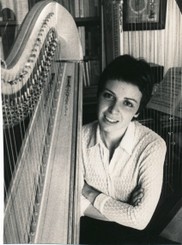 Donatoni: Souvenir (Kammersymphonie op.18) | ||
Most of the activity of every solo harp performer is focused on a few important works,as we don’t have such a wide-ranging repertory. First of all Mozart Concerto K299 for flute, harp and orchestra, then Debussy Deux Danses, Debussy Deuxième Sonate pour flute, viola and harp, Ravel Introduction et Allégro pour harpe, flute, clarinette, quatuor à cordes, Boieldieu Concerto with orchestra, Fauré Impromptu op.86. I played Mozart’s Concerto for the first time in 1973 together with Conrad Klemm, Igor Markevitch and Accademia di S.Cecilia’s Orchestra.It was an extraordinary experience I was not able to appreciate in its actual worth. At that time I was twentyone and only concerned in performing correctly without mistakes.This attitude went on for some years, however I kept on performing it each and every year with several flutists and well known conductors, in more or less important venues. I can remember Severino Gazzelloni in Naples, Turin,Rome with the Italian Radio Orchestras 1974/82;with Jean-Pierre Rampal and Solisti Veneti in Padova, Verona and Turin in 1976; with Angelo Persichilli, Mario Ancillotti and Giorgio Zagnoni all over Italy with small and big orchestras, with Philippa Davies and St.John Smith’s Square Orchestra at the Barbican Center in London in 1985. From 1978 to 1987 I had a special encounter with Wolfgang Schulz and Philippe Entremont in Vienna Konzerthaus, where I felt to be in the best context to perform this work. Before Vienna I had performed Mozart in Berlin with Irena Grafenauer and Bruno Weil, in the grosser Saal of the Philharmonie; at that time the town was still divided into two parts by a wall and passengers still landed in Tempelhof Airport,evoking the cold war and spy stories. In 1991 I performed it in Naples for the “Settimane Musicali di Napoli” - Salvatore Accardo musical director - with Prague Chamber Orchestra.In 1999 I had another special encounter with Andras Adorijan, extraordinary flutist who enthralled me with his artistry.When you happen to have the opportunity to play at a such high level you feel to be over the moon and get to play your best. A special thank is due to Lydia Oshavkova, excellent Bulgarian flutist and outstanding musician.We met for the first time in 1974 to perform this Concerto with John Pritchard and Sofia Philharmonie; later on we met and performed together several other times in our lives up to 2009.Our relationship, both as musicians and friends, has been lasting for decades and we are still in touch for Christmas greetings.We performed and recorded the Mozart Concerto with Ivan Konzoukharov and many other conductors. W. A. Mozart Concerto K299. Live Press: | ||
My first performance of Debussy Deuxième Sonate was also my first time as a soloist in an important musical association and I played with accomplished,well known artists, such as Severino Gazzelloni flutist and Dino Asciolla violist.In 1972 we performed it for Accademia Filarmonica Romana, Unione Musicale in Turin and Teatro Comunale in Mantova. In 1975 the Filarmonica Romana scheduled this work once more inside a chamber music programme completely dedicated to Debussy.This time my partners were Bruno Giuranna and Mario Ancillotti.I remember this performance as one of the most inspired and well organised Debussy Sonate I have ever done,above all thanks to Bruno Giuranna who drove us to the right mind and the right mood to play it.After that I tried for years to create a suitable programme around Debussy but it was hard because of the shortage of repertory for this kind of ensemble. That was realized several years later,adding Ida Levin as violinist and programming the most amazing chamber music works:Mozart duet, Beethoven Serenata, Fauré Impromptu, Saint-Saens Fantaisie op.124 and Debussy Sonate.In 1988 we performed this programme in Pesaro,Perugia, Genova, Padova, Siena and Roma. I felt to be over the moon and completely inside the music in this case too and I was sorry we no longer went on performing it. Throughout the years I have performed the Debussy Sonate a lot of times,including it in different kinds of programme and together with several Italian and foreign instrumentalists. Most performances took place in Italy but sometimes we also performed in Spain,Germany, Finland and Bulgaria. Making up a suitable repertory to realize a nice programme was always the hardest thing ,so that we used both classical composers-such as Mozart and Brahms-and composers belonging to the XXth century (Malipiero, Schmitt,Ghedini, Bax,Jolivet, Zafred, Pennisi, Donatoni, Takemitsu Gubajdulina). The last attempt was also the best achievment;in 2000 Manuel Zurria, Garth Knox and I performed Debussy at Echternach Festival in Luxembourg together with the first performance of “Isola Volante” by Claude Lenners. C. Debussy: Deuxième Sonate-Final Press: | ||
My first encounter with “Ravel Introduction et Allégro” happened in 1969. While I was still attending the Conservatory I had the opportunity to perform this work together with some of my mates.Even if I was still very young and all the time concerned to play my score the right way, this event let me glimpse a wonderful musical world I could enter, by means of practising,studying by heart and keeping under control my emotions. After that I performed it again but the first important venue was the Spoleto Festival at Caio Melisso Theatre in 1974,inside a chamber music programme completely dedicated to the harp and including, apart from Ravel, Debussy Sonate and Debussy Deux Danses. The year 1975 was the centenary of Ravel’s birthday therefore it offered several opportunities to perform his work. We recorded it for the Rai TV together with the Ottetto di Roma and later on we performed it in many musical associations in Italy and Spain. I performed it with the Radio Orchestra in Turin and with Accademia di S.Cecilia Orchestra in Rome, conducted by Igor Markevitch. He achieved this performance with flute, clarinet and the whole string orchestra, explaining that Ravel himself authorized this adaptation on the occasion of performing it with the Suisse Romande Orchestra. Inside the same programme Markevitch also conducted the Boléro, that was the most amazing moment of the concert.In the same year I performed Ravel again with “Solisti di Teatromusica”, ( Marcello Panni conductor) for Académie de France in Rome, at Spoleto Festival Teatro Caio Melisso chamber music season, inside a programme completely dedicated to Ravel, in Naples “Settimane Internazionali di Napoli”, (Salvatore Accardo musical director), where I had the opportunity to play together with outstanding instrumentalists from all Europe and the USA. In 1978 I performed it again with the whole string orchestra “Rai Scarlatti” in Naples, conductor Peter Maag, then several times for Accademia Filarmonica Romana with different groups of instrumentalists, in 1981 in Ottawa with the group “13 Strings” conductor Brian Law, in 1985 again for Accademia di S.Cecilia in Rome, in 1986 for Settembre Musica in Turin with Gruppo Musica d’Oggi,in 1987 with instrumentalists from Orchestra da Camera di Padova,in 1988 with the Ensemble directed by Vladimir Spivakov for Settimane Internazionali di Napoli,in 1989 as a conclusion of a seminar at Catania University, in 1991 in Sofia with Sofia New Chamber Ensemble conductor Metodij Mataev both performing and recording it and in the same year at Khumo Festival(Finland) with Isabelle van Keulen,Aurin Quartett, Petrij Alanko and Charles Neidich.In 1992 I performed it again with Gruppo Musica d’Oggi for Teatro Massimo in Palermo and, for the last time,in 2005 for Rai Quirinale with Algoritmo Ensemble. What turns out clearly from this list of performances is that creating the conditions to put together the required instrumentalists to perform this work became harder and harder going on throughout the years. The taste of the public and the targets of musical directors were already changing for the worse during the nineties. It is really a pity we can play and listen to this work so rarely. Ravel: Introduction et allegro Press: | ||
I had studied “Debussy Deux Danses pour harpe et orchestre à cordes” for some years before performing it and, during this period, I received a great support by two outstanding harpists and excellent professors, Pierre Jamet and Susanna Mildonian. On this connection I want to make it clear that all the suggestions and advices I received from different professors, that afterwards I elaborated again on my own, helped me to build a steady technical structure useful to master a work. Rather I have always had a personal musical idea of all the works I studied and I have been always quite sure of my interpretation,without taking in any consideration other possibilities. Finally in 1975 I performed it with Radio Orchestra in Turin. Later on I performed it with Radio Orchestra Scarlatti in Naples in 1977, Sofia Chamber Orchestra in 1978, in 1982 with Haydn Orchestra (conductor Hermann Michael) and with ORT (conductor Lev Markiz) in Fiesole and Siena, in 1984 with Pomeriggi Musicali Orchestra Milan and with Solisti Aquilani in Roma Teatro Argentina, in Sevilla with Orquesta Betica in 1985 and in Vienna with Wienerkammerorchester, Wolfgang Schulz and Philippe Entremont in 1986. It took me a longtime to penetrate and to widen my knowledge of this work;only while performing in Vienna I was actually able to master the subject both technically and musically keeping the score clear-cut in my mind. Afterwards I performed it again with Wienerkammerorchester in Vienna Konzerthaus and Linz Brucknerhaus in 1987. In 1991 with EAOSS in Palermo and Accademia di S.Cecilia (Gabriele Ferro conductor), with Sofia New Chamber Ensemble (Metodij Mataev conductor) performance and cd, in 1993 in Cagliari Teatro Lirico,in 1994 with Hessisches Theater Orchester (Theodore Guschlbauer conductor), in 1995 in Rome with ORL (Anton Reck conductor), in 1997 in Florence Teatro Comunale with Fiesole Youth Orchestra, in 2001 with Solisti Aquilani, in 2003 again in Cagliari Teatro Lirico, in 2004 with Poznan Philharmonic Orchestra and with Zarbrze Philharmonic Orchestra. My last performance of Debussy,which was also my last public performance,took place at Berlin Philharmonie Grosser Saal (Gerd Albrecht conductor). I enjoyed it completely and preserved it in my soul all the time.Now it is a part of myself. C. Debussy: danse sacrée 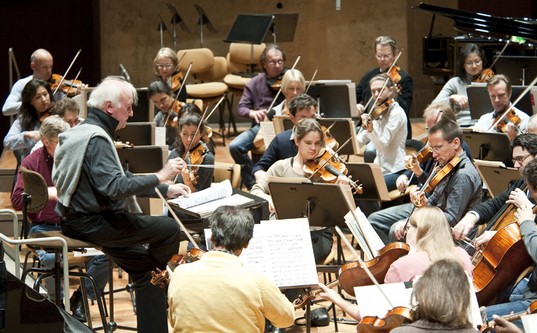 Philharmonie Berlin Grosse Saal 03.11.2009 Debussy Deux Danses Symphonie Orchester Berlin Gerd Albrecht conductor Claudia Antonelli harp Press: | ||
I discovered the Boieldieu Concerto when I was still a teen-ager listening to the LPs recorded by Nicanor Zabaleta, Lili Laskine and Susanna Mildonian. I have dreamt for years of playing at a later stage.At once it was clear in my mind I would have succeeded in realising this project only if I had improved my technique, what I tried to do up to 1977. In that year I performed Boieldieu in Siena for Accademia Chigiana(Settimana Musicale Senese) and a short time later in Rome for Accademia di S.Cecilia. In 1979 I performed it with Radio Orchestra in Turin (conductor Charles Bruck), in 1982 with Orchestra Haydn (conductor Hermann Michael), in 1983 in Naples with Radio Orchestra Scarlatti, in 1985 in Genoa with Teatro Carlo Felice Orchestra (conductor Yan-Pascal Tortelier), in Parma Teatro Regio and Bergamo Teatro Donizetti with Radio Orchestra Milan (conductor Anton Nanut).In 1986 I recorded this Concerto-together with Haendel and Ditterdorf-for Arts with Innsbruckerkammerensemble (conductor Hans Ludwig Hirsch). In 1988 I performed it again in Linz Brucknerhaus with Salzburger Mozarteum Orchestra and in 2004 with Zarbrze Philharmonic Orchestra at Silesian Music Festival in Poland. This Concerto points out the virtuosity on the harp; since the harp as a solo instrument had already begun to be neglected after 2000, at the same time scheduling this Concerto inside orchestra seasons has been decreasing and then fading at all up to now. | ||
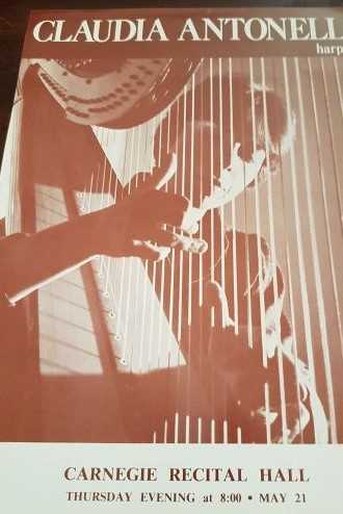 | ||
Press: | ||
I studied “Fauré Impromptu op.86” late in my career, only when it was included in a chamber music programme with flute, violin and viola in 1988. Of course I knew it was a masterpiece of the harp repertory, but unfortunately a lot of engagements requiring different works prevented me from knowing and practising this work.While composing this piece,definitely Fauré made up the most congenial and producing technique ever created for the harp,what makes easy approaching to it under the technical point of view.At the same time, however, he put inside modulations demanding several hard changements of pedals,that we have to fixe in our mind and keep there once and for all. The most difficult challenge, however, is understanding and taking out,among thousand of notes,the musical line. With regard to this last subject, I have to say that most of harpists don’t take so much care of music and get lost inside a lot of notes without penetrating their deep musical meaning. That’s why our instrument is often neglected and even despised and sometimes we are not taken into consideration as musicians. After the first time I had performed Fauré, I included it in almost all the following recital programmes I played, wherever and whenever possible. It got me to become more mature and to face works,such as for instance Britten or Hindemith or others,with much more musical understanding than during the previous years of my activity. I performed hundred of solo harp recitals, so many that I can’t remind and count all of them but only their highlights. 1974 in Sofia;1976 Piccola Scala Milan and Radio in Venice; 1977 Sender Freies Berlin and Hamburg Rundfunk; 1978 Radio Suisse Romande Lausanne and Torino Piccolo Regio; 1979 Hamburg Musikhalle, Radio in Copenhagen, Stockholm and Oslo, Estate Fiesolana, Dublin National Gallery; 1980 Accademia di S.Cecilia and Amsterdam Concertgebow; 1981 Treviso Teatro Comunale, tournée in Canada, London Queen Elizabeth Hall/Purcell Room, New York Little Carnegie Hall; 1985 tournée in Spain and Brazil; 1986 tournée in Japan, 1986 and 1989 recital in Malta; 1989 Teatro alla Scala,tournée in Japan and Australia; 1990 tournée in Japan; 1999 in Belgium Louvain, Gand and Brussels, in France Lyon, Tours,Clermont-Ferrand and Grenoble; 2001 tournée in Germany; 2003 Strasburg; 2004 Koper, Lubijana, Osijek, Zagreb and tournée in Poland; 2007 tournée in China; 2008 New York Merkin Hall and Los Angeles, tournée in South Africa. Krenek: sonata I° mov. Britten: suite (overture) toccata fuga Pescetti: andantino (transcription Salzedo) Rota: sarabanda e toccata Roussel: Impromptu Press: | ||
| In 1984 I agreed with Frequenz to record a LP about transcriptions for solo harp of favourite arias from Italian famous operas by Bellini and Verdi,whose title was “Harp Operatic Recital”.During the XIXth century the habit to play arrangements of lyrical works by means of solo instruments or small instrumental groups was widespread, both at home and holding a salon. In order to make up a good programme I looked up in the musical library of the Accademia Filarmonica Romana, and I got to create a nice programme though, usually, the taste of this production is not so refined. In the years 1985/1988,apart from the LP, I recorded the same programme for a TV broadcasting and then I performed it in Rome Concerti Aperitivo Teatro Sistina, Teatro Manzoni Milan, Estate Fiesolana and some other places. Bellini: Casta diva |
| I have performed flute and harp recital programmes a thousand of times for decades, together with many Italian and foreign flutists both in Italy and abroad.That could appear funny, if we consider, that the repertory for these two instruments doesn’t have such amazing works and no outstanding composer took into consideration this kind of ensemble (except for Mozart K299 with orchestra). Most of its repertory is made by trancriptions or arrangements coming from other instruments, such as piano and flute or flute and guitar. Neverthless this kind of duo got a high quantity of performances. In my opinion the artistic directors thought a flute and harp recital could be more attractive for the audience than a solo harp recital; therefore,because of their ignorance and lack of courage, this low artistic level repertory had so many opportunities to be performed even if it wouldn’t be worthing. Trapani 1: Concerto (recital flauto e arpa) 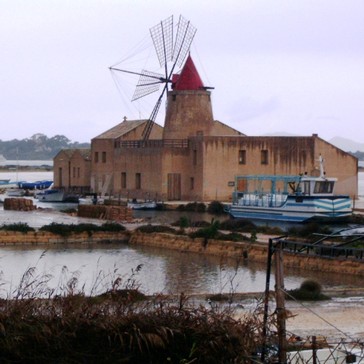 |
Right now I just want to mention some Concertos with orchestra I performed, both those works I studied especially for a particular chance and those that were performed several times in more venues. The first time I had performed as a professional harpist with an orchestra was in Milan in 1973; Dittersdorf’s Concerto was scheduled in the season of Pomeriggi Musicali Orchestra (conductor Lazslo Somogyi). This conductor sent for me and asked me to play my score for him; after a short time he told me: ”you play it too well in comparison with the value of this music”. Press: |
In 1975 I performed the Concerto by Virgilio Mortari with the Pardubice Chamber Orchestra (Libor Pesek conductor) in some cities of Bohemia;in 1976 I performed the Concertino by Mortari for harp and strings with Prague Chamber Orchestra for Radio in Milan and in the same year I performed the V Concerto by Krumpholz with the Philharmonic Orchestra in Bratislava (conductor Antoni Witt).In 1975 I performed Nino Rota’s Concerto with the Pomeriggi Musicali Orchestra in Milan and in 1993 with the Teatro Lirico Orchestra in Cagliari.In 1980 I had the extraordinary opportunity to perform Ginastera’s Concerto while conducting Eduardo Mata in Rome for the Radio, an exciting musical and emotional experience; later on I performed it again (conductor Michel Sasson) with the Teatro Massimo Orchestra in Palermo.In 1980 I performed the Concerto by Villa-Lobos at Gottwaldov Festival in Moravia and the following year 1981 with the Radio Orchestra in Turin (conductor Niklaus Wyss). In 1984 I performed Saint-Saens’s Morceau de Concert with the Pomeriggi Musicali Orchestra in Milan, in 1985 with Orquesta Betica in Sevilla and in 1999 with ORL in Rome; in 1986 I performed Zafred’s Concerto with the Radio Orchestra in Rome (conductor Miltiades Caridis). At last I want to remember a work by Harrison Birtwistle “Melencolia I”for clarinet, harp and 2 string orchestras, not owing to its worth rather because of the venue where we performed it,Felsenreitschule at Salzfestspiele with the ORT, clarinet Karl Leister and conductor Leopold Hager in 1986. 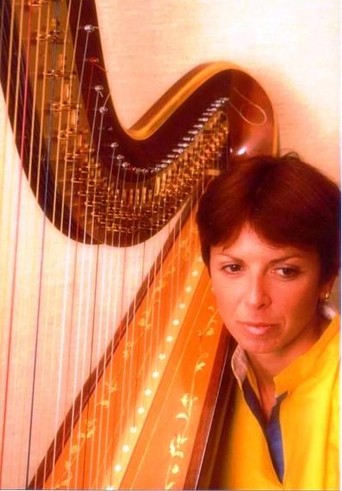 Press: |
I think it is worth speaking a bit about Rodrigo and Henze/C.P.E. Bach. Rodrigo wrote a delightful Concierto Serenata for Nicanor Zabaleta. The original score for the harp was actually extremely hard and almost impossible to perform as the composer wrote it down; owing to that Zabaleta made an arrangement and transformed it in a quite different thing,closer to the instrumental capacities but far from what Rodrigo probably thought. I studied the original score and I arranged only what in my opinion and in my skill was definitely out of reach to realize. In 1982 I performed Rodrigo with the Radio Orchestra in Rome (conductor Guenther Neuhold), in 1985 with Orchestra Sinfonica in L’Aquila, in 2004 with Philharmonic Orchestra in Poznan and in 2008 with Johannesburg Philharmonic Orchestra. Rodrigo: Concierto Serenata |
Nicanor Zabaleta made an excellent arrangement of the Concierto de Aranjuez originally written for guitar and orchestra;in my opinion it sounds much better played by the harp that is more resonant and more expressive than the guitar.After Rodrigo’s death, that happened in 1999, the Orchestra Filarmonica Marchigiana scheduled a lot of performances inside its area in 2000; I took part as a soloist together with the conductor Daniele Agiman. In 1982 Hans Werner Henze was the artistic director of the Accademia Filarmonica Romana.He wrote a delicious work especially for me, Mario Ancillotti flutist and Gruppo Musica D’Oggi to be scheduled in the season of the Accademia. He took the idea from a fantasie by C.P.E.Bach and translated this work for flute, harp and strings with the title “C.P.E.Bachs Empfindungen”. We played it as the first performance. Being a part of the contemporary musical ensemble, “I Solisti di Teatromusica”, put me in touch with several Italian composers and gave me the opportunity to establish relationships with some of them. That brought about, I got new works especially written and dedicated to me by them.During those years the first composer I had made the acquaintance of was Luciano Berio, already an accomplished musician in Italy and abroad. He has always been satisfied with me as an instrumentalist beeing a part of small groups while performing, for instance, Circles with Cathy Berberian, Folk Songs, Différences etc. On the contrary he was always criticizing me while performing Sequenza IIa.Neverthless I performed Sequenza thousand of times all over the world so that I can no longer count how many. Once in 1980 I had the opportunity to perform Chemins I with the Radio Orchestra in Milan (conductor Richard Dufallo). He seemed to be a bit drunk, however the performance was good and gave a tough impression to the audience. Luciano Berio as a person was difficult to deal with rather he had a great glamour. Berio: sequenza II Press: |
| Meanwhile I met M°Goffredo Petrassi, a nice,gentle and fair person, the father of the Italian XXth century music. In 1972 we performed the Seconda Serenata-Trio for harp, guitar and mandoline in Venice Biennale and some years later we recorded it inside an LP for Fonit Cetra, completely dedicated to Petrassi’s chamber music. My actual encounter with him,however, took place in 1979 when he wrote and dedicated to me “Flou” for solo harp, that I played as a first performance in Siena Accademia Chigiana in 1980. I recorded Flou the first time in an LP totally dedicated to contemporary harp music for Fonit Cetra and later on in a cd for Arts dedicated to the harp XXth century music. I performed Flou thousand of times all over the world. Petrassi: Flou |
| During the same years I met Franco Donatoni,Italian composer very well known since the sixties. I took part in many performances of his works, such as “Secondo Estratto” for piano,harpsichord and harp and “Souvenir” for a small mixed up group.My actual relationship with him, however, started in 1980 when I performed “Marches” for solo harp in Siena Accademia Chigiana and later on I recorded it for Fonit Cetra.Ten years later we renewled our contact when he wrote and dedicated to me a new work”Marches II” for main harp and 15 instruments which I played as a first performance in Alessandria Teatro Sperimentale in 1990.Afterwards I performed it again with the Radio Orchestra in Rome (conductor Liu Jia) in 1991. In 1993 he wrote “Small II”,a trio for flute, viola and harp we played as a first performance in Scuola di Musica di Fiesole and a short time later in Darmstadt Orangerie. Donatoni: Marches Marches II Press: La Nazione Siena agosto 1980 Bonn 1° febbraio 1994 |
I met Salvatore Sciarrino in 1971, at the very beginning of my attendance in the group “Solisti di Teatromusica”.At that time he was about 25,a nice person but not very fond of the harp that he used to put in the score very rarely. In 1980, when I had the opportunity to record an Italian contemporary harp music LP, he was pushed to write a small piece “L’addio a Trachis”,utilizing a restricted but genial material. The whole piece lasts less than 5 minutes, however inside that space he blows all his genius. After some months he wrote another work for flute and harp “Fauno che fischia a un merlo”, by means of the same fragments and ideas he used for Trachis, what we performed in Florence in August 1980. I performed both these works so many times all over the world that I don’t even try to remind where and when. About him as a person, I just want to point out while getting old he also became malignant and poor, what doesn’t suit to a genius; evidently his human heart is miserable. Sciarrino: L'addio a trachis |
I left Bussotti and Pennisi as the last ones because our relationships have gone on for decades throughout the years and because they extimated me a lot and wrote several works for me.I met both of them at the very beginning of the seventies when I started beeing a part of “Solisti di Teatromusica”. During the first years I was still very young and only afterwards I began performing their works as a soloist. In 1977 I performed “Fragmentations pour un joueur de harpes” by Sylvano Bussotti in Rome Teatro Argentina and later on I recorded it in a LP for Fonit Cetra, what he appreciated a lot. After this opening between 1987 and 1992 Bussotti wrote“Labirinti”, a second solo harp work in 4 pieces dedicated to Alain Daniélou, eachone of them imagined as a picture, what I tried to realize by means of dinamica. In 1992 I played them as first performance in Genazzano Bussotti Opera Ballet and a lot of times going on; I recorded it for Arts in 1998. In 1995 Bussotti used fragments coming from “Labirinti” and also something from “Fragmentations” to build an awesome work, ”Madrelingua”, for solo harp, male choir and orchestra that I played as a first performance in Rome Accademia di S.Cecilia (conductor Daniele Gatti) in 1996. Press: Corriere - Repubblica Roma 14 maggio 1996 |
The last work he wrote for me was “Notti silvane”-Concerto Grosso all’ara degli ulivi N°4 for solo harp and 19 solo strings, committed by Teatro Lirico di Cagliari that I played as a first performance in 2003. I can say we have always had a special and exquisite artistic relationship but I have never got to feel his human nature. Bussotti: Primo Labirinto 1987 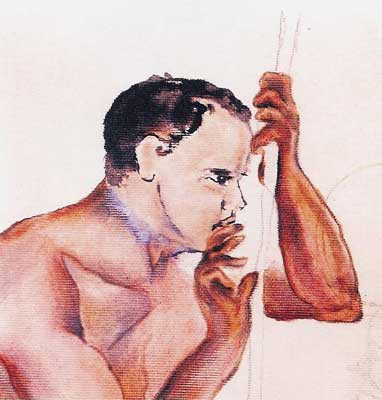 Press: |
In 1978 Francesco Pennisi, composer and painter from Sicily, wrote for me a delicious work “Madame Récamier-due capricci per arpa”, that I played as a first performance at Spoleto Festival in 1979. When he came to me together with this piece he was not sure it would be possible to realize on the harp and left it with me to read and give him my opinion about it. Actually it was very hard to perform rather absolutely playble on the instrument. He included in the score some designs by himself featuring Madame Récamier and her harp in the “Directoire style” and most likely he was inspired, while writing this piece, by the image of the harp he could see in pictures by Ingres and David. Later on in 1982 he wrote the “VI Trio” for flute, viola and harp we performed for the first time for Accademia Filarmonica Romana. In 1984 he wrote a nice small piece for flute and harp “Introduzione al Grecale”, dedicated to me and to Mario Ancillotti on the occasion of a tour we had planned all over Sicily. We performed all these works a lot of times in Italy and abroad during the following years.(Wiesbaden Pariserhoftheater, Bonn Redoute der Beethovenhalle, Darmstadt Orangerie etc.). Finally in 1984 he wrote the first work for solo harp and chamber orchestra “L’Arrivo dell’Unicorno”, that I played as a first performance for Accademia di S.Cecilia in 1985, in Naples with Radio Orchestra Scarlatti and in Milan with Pomeriggi Musicali Orchestra in 1986. I recorded “Madame Récamier” for Fonit Cetra, ”VI Trio” and “Grecale” for Ricordi. In 1991 I had the opportunity to arrange a commission by Accademia di S.Cecilia and on this occasion Pennisi wrote a work in only one movement taking out the idea from Ariosto - Orlando Furioso, ”Angelica in bosco”for solo harp and symphony orchestra. I performed it again with Radio Orchestra in Milan in the same year.He died in 2000. In 2002 Accademia Chigiana in Siena set up an exhibition of his watercolours, supported by a performance of some among his chamber works. On this occasion Mr.Pugliaro wrote the programme-notes saying that “Unicorno” and “Angelica” were written for Accademia di S.Cecilia, what was quite wrong. Pennisi wrote these works especially for me and it was I to make an agreement with the President of S.Cecilia in order to schedule their first performances inside their seasons. Pugliaro may have been too snobbish to get informed about this subject more carefully. I have got some of Pennisi’s watercolours he gave me as a present, always featuring landscapes and lights of Sicily, which correspond exactly to his musical creations. He was a discreet, fair and gentle person, so jealous of his intimate world that I have never got to reach it. |
Pennisi: Acquerelli 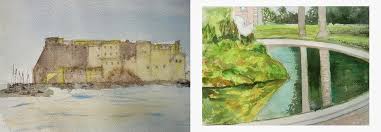    |
I met many other good composers and played so many other first performances that I can’t name all of them here. Some years ago I had to quit my professional life and stop playing my instrument,owing to physical problems concerning my hands. Beeing out of the musical environment, however, allows me to point out that unfortunately the professional life of an artist,and all his personal and intimate implications, depend on the artistic directors. People void of qualities,who wouldn’t be able to put their hands on a musical instrument or to follow a conductor, sometimes even ignorant of music, can joke as they like with the life of an artist. They only take into account their power, relationships,profits,give and take and going on. At a long last I could get rid of them and become a free person.  |